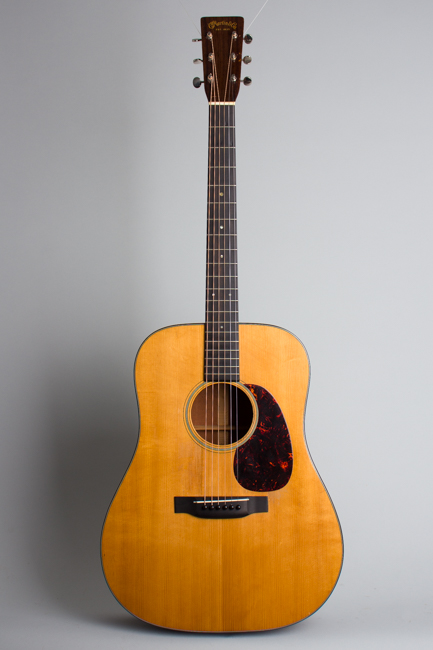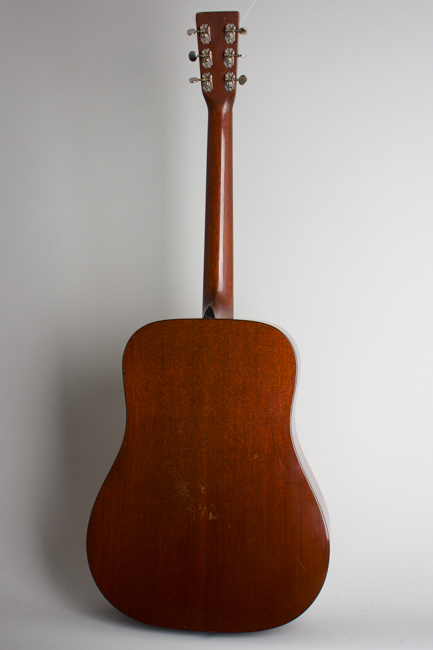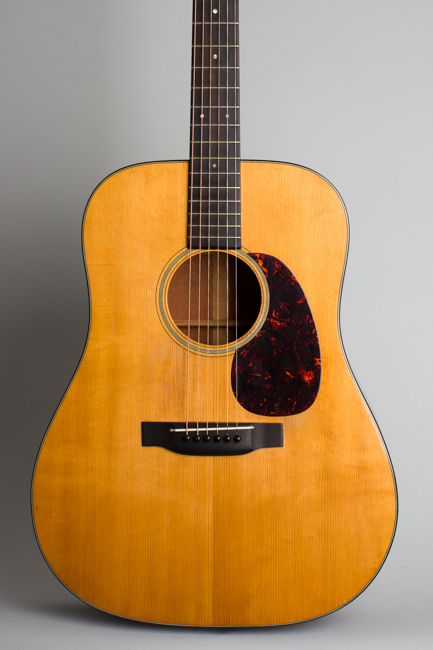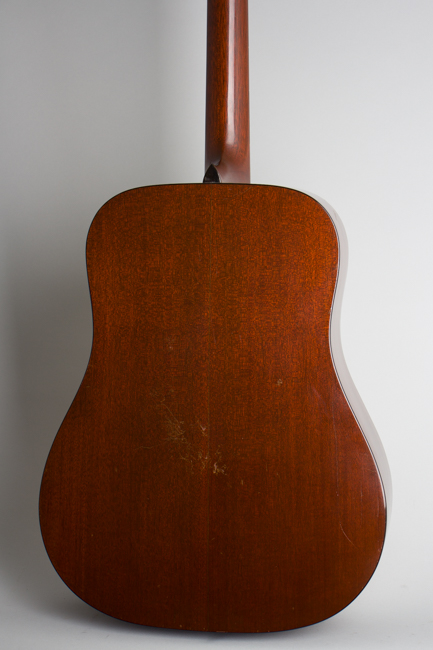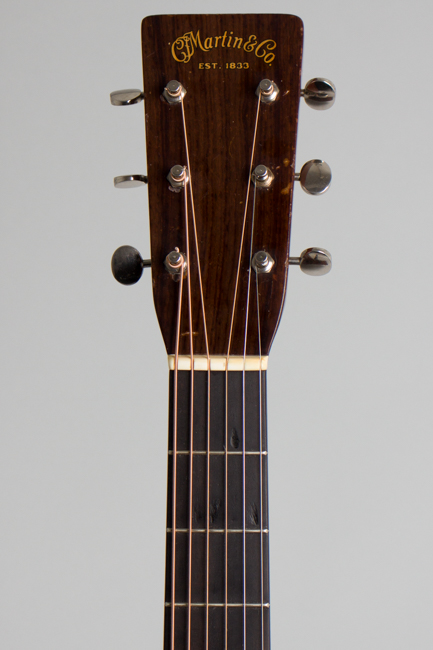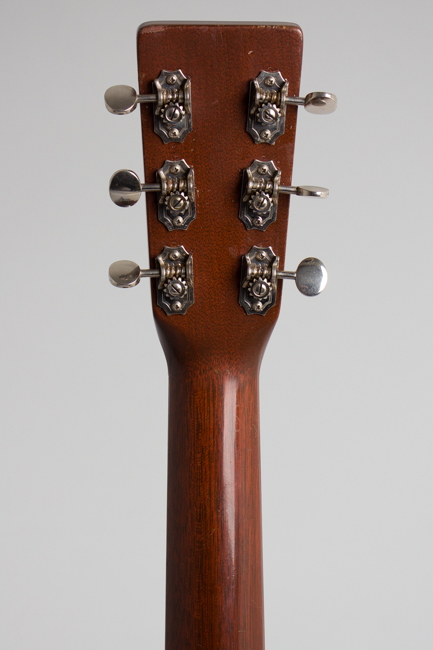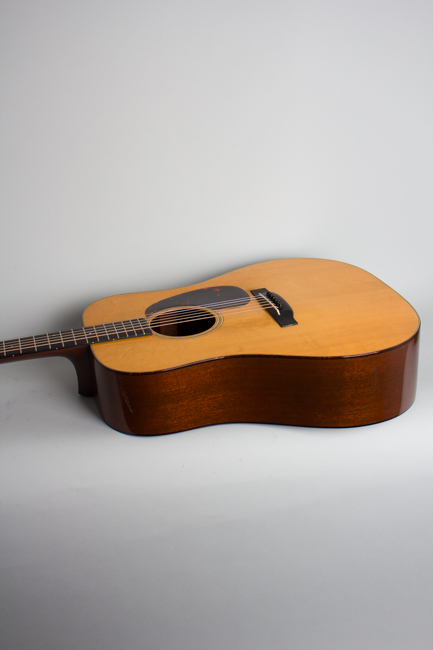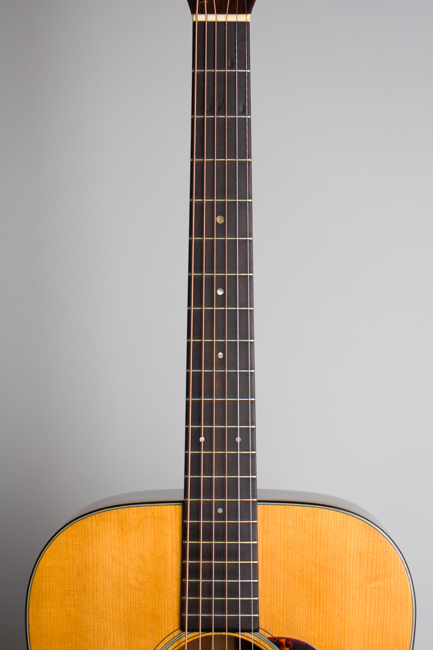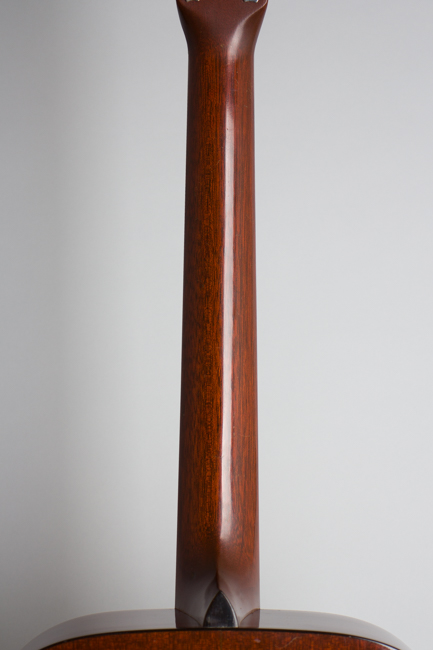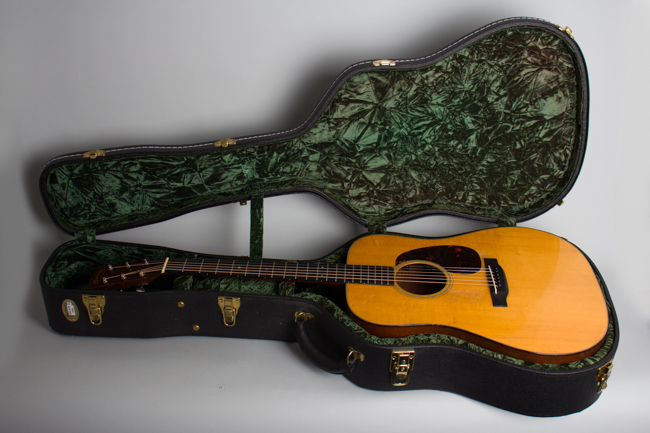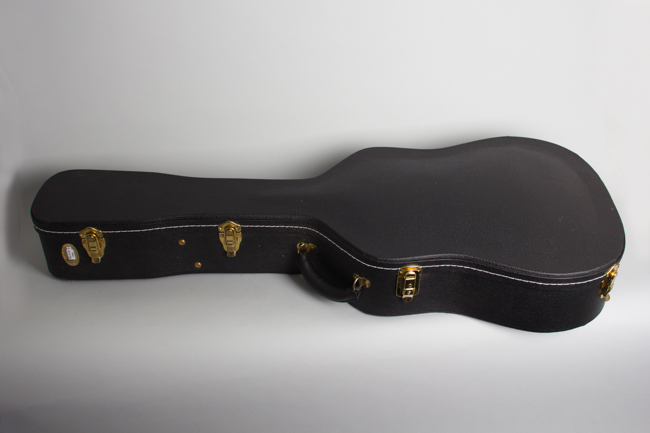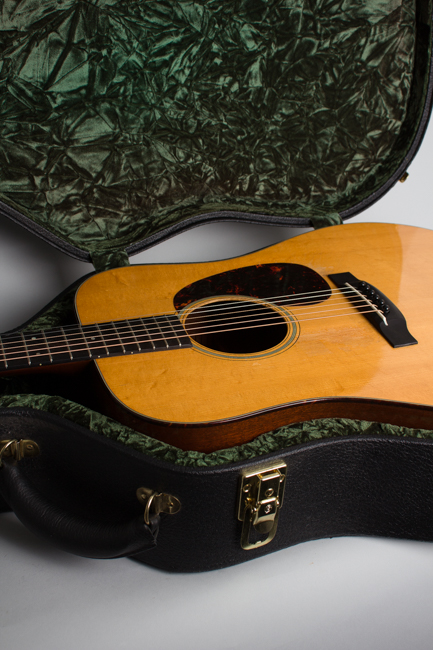C. F. Martin D-18 Flat Top Acoustic Guitar (1941)
End of Summer Sale - PRICE REDUCED!
This item has been sold.
Item # 10655
Prices subject to change without notice.
C. F. Martin D-18 Model Flat Top Acoustic Guitar (1941), made in Nazareth, PA, serial # 78586, natural lacquer finish, mahogany back, sides and neck, spruce top, ebony fingerboard, black tolex hard shell case.
Certain guitars have long been the standard by which all others are judged; the Pre-war Martin D-18 is always one of them. This mid-1941 example represents a beautifully played in original 14-fret mahogany Dreadnought that has seen endless imitations but very few peers since its birth. While the guitar shows a decent amount of playwear it remains in excellent playing condition and offers the expected fantastic sound in spades. The power and depth of a Dreadnought combines with the sweetness, sparkle, and singing character of the best pre-WWII mahogany Martins in a magical mix, making this an exceptionally versatile flat-top guitar suited to practically any musical situation.
This D-18 shows the classic pre-war features of the model, introduced in this form in late 1934 and widely imitated ever since. The back and sides are Honduras mahogany and the top is tight-grained Appalachian spruce, bound on the edge with tortoise celluloid. The ebony belly bridge has a canted bone saddle. The pickguard is made of tortoise celluloid in a small "teardrop" shape, a design that often proved too small to fully protect the top from the ravages of enthusiastic picking, something well displayed on this one.
The neck is mahogany with an unbound ebony fingerboard discreetly inlaid with small mixed-size pearl dots. The peghead is faced in Brazilian rosewood with the gold "C.F. Martin & C." decal at the top. The neck profile is fairly slim, round backed but with the increasing hint of a "V" profile in the way the sides bear away from the center as it moves towards the heel. The nut is slightly narrower than mid-thirties examples. The string spacing is 2-5/16" from low to high E at the bridge. The tuners are open back individual Kluson units with metal buttons specific to this exact period.
While this guitar shows signs of serious use, there is less wear and repair evident than is often found considering how these instruments often got used playing on radio or barn dance stages. In this situation a guitar had to have exceptional power and projection. A large percentage of period Country and Western performers found Martin Dreadnoughts the best instrument for their situation. In 1941 the price of a new D-18 was $83 (without case), a sizable expense for many at the time. They sold decently by contemporary standards, with 575 shipped that year. By the 1950s Martin was building two or three times that number every year; pre-war examples were scarcer even then. Today over 80 years later finding a 1941 example even as well preserved as this one is a fairly rare occurrence.
In the minds of most acoustic guitar players, collectors, and historians, very few instruments approach the pre-war Martin Dreadnought in terms of sound and historical importance. Compared to all that's come down the pike since, this is still one of the finest performing or recording guitars imaginable. While the rosewood D-28 is optimized for power and bass response, the D-18 is often a more versatile instrument combining the mellow depth of the Dreadnought with a crisp, slightly dry mahogany ring. This is a truly great early pre-war example, well played over the decades but also well-cared for and ready for many more years of service.
Overall length is 40 3/4 in. (103.5 cm.), 15 5/8 in. (39.7 cm.) wide at lower bout, and 4 7/8 in. (12.4 cm.) in depth at side, taken at the end block. Scale length is 25 1/2 in. (648 mm.). Width of nut is 1 5/8 in. (41 mm.).
While certainly not pristine this is a relatively well preserved and nicely original guitar overall. Cosmetically it shows evidence of years of serious play time. There is pick wear on the top, but no cracks. This is deepest around the lower edges of the pickguard and the treble side of the sound hole, worn through to the wood on the treble side rosette, the bass side between the soundhole and the bridge, the treble side and bottom of the pickguard. On the bass side, there is also a trapezoidal area of wear through the finish where a sticker or mail box letters were likely placed and removed. There is also light strum wear throughout the upper bouts and a "case lid bite" to the top on the upper bass side.
An area of buckle rash is visible on the back, largely on treble side. There are three sealed cracks on the bass side of the lower back; one runs from the waist and there are two more closer to the apex of the lower bout. There are no other cracks on the guitar. Both sides show only light scuffs and dings, with a larger rub mark at the apex of the bass rim upper bout.
The finish on the back of the neck shows only a few light marks. There are two filled strap button holes, one on the spine of the heel and one on the treble side of the heel. Both have been neatly filled and touched up. The neck has been neatly reset and the guitar nicely refretted with correct style wire. The ebony bridge is a replacement made to the same contours and shape as the original, with only a few slight marks around the edges to show that the work was completed. The tuners are the correct original open-back Klusons with metal buttons; there are small marks from something else fitted at some point but the shaft holes were not enlarged. Internally, the glue lines from the back crack repairs can be seen; also a little sawdust and glue has been added to the original small maple bridge plate to strengthen the pin holes in a minimally invasive way.
This D-18 is a truly excellent playing example, set up with a good flatpicking action (3/16" bass and 2/16" treble) and room to lower the saddle if a mellower fingerpicker's approach is desired. In any playing situation the sound of these lightly built pre-war Dreadnoughts is truly inspiring, and this one certainly does not disappoint. An extremely fine sounding D-18, this guitar has been used but not abused remaining more original than many for over 80+ years now. With some care it will still be providing wonderful sounds for many decades to come. Excellent - Condition.
Certain guitars have long been the standard by which all others are judged; the Pre-war Martin D-18 is always one of them. This mid-1941 example represents a beautifully played in original 14-fret mahogany Dreadnought that has seen endless imitations but very few peers since its birth. While the guitar shows a decent amount of playwear it remains in excellent playing condition and offers the expected fantastic sound in spades. The power and depth of a Dreadnought combines with the sweetness, sparkle, and singing character of the best pre-WWII mahogany Martins in a magical mix, making this an exceptionally versatile flat-top guitar suited to practically any musical situation.
This D-18 shows the classic pre-war features of the model, introduced in this form in late 1934 and widely imitated ever since. The back and sides are Honduras mahogany and the top is tight-grained Appalachian spruce, bound on the edge with tortoise celluloid. The ebony belly bridge has a canted bone saddle. The pickguard is made of tortoise celluloid in a small "teardrop" shape, a design that often proved too small to fully protect the top from the ravages of enthusiastic picking, something well displayed on this one.
The neck is mahogany with an unbound ebony fingerboard discreetly inlaid with small mixed-size pearl dots. The peghead is faced in Brazilian rosewood with the gold "C.F. Martin & C." decal at the top. The neck profile is fairly slim, round backed but with the increasing hint of a "V" profile in the way the sides bear away from the center as it moves towards the heel. The nut is slightly narrower than mid-thirties examples. The string spacing is 2-5/16" from low to high E at the bridge. The tuners are open back individual Kluson units with metal buttons specific to this exact period.
While this guitar shows signs of serious use, there is less wear and repair evident than is often found considering how these instruments often got used playing on radio or barn dance stages. In this situation a guitar had to have exceptional power and projection. A large percentage of period Country and Western performers found Martin Dreadnoughts the best instrument for their situation. In 1941 the price of a new D-18 was $83 (without case), a sizable expense for many at the time. They sold decently by contemporary standards, with 575 shipped that year. By the 1950s Martin was building two or three times that number every year; pre-war examples were scarcer even then. Today over 80 years later finding a 1941 example even as well preserved as this one is a fairly rare occurrence.
In the minds of most acoustic guitar players, collectors, and historians, very few instruments approach the pre-war Martin Dreadnought in terms of sound and historical importance. Compared to all that's come down the pike since, this is still one of the finest performing or recording guitars imaginable. While the rosewood D-28 is optimized for power and bass response, the D-18 is often a more versatile instrument combining the mellow depth of the Dreadnought with a crisp, slightly dry mahogany ring. This is a truly great early pre-war example, well played over the decades but also well-cared for and ready for many more years of service.
Overall length is 40 3/4 in. (103.5 cm.), 15 5/8 in. (39.7 cm.) wide at lower bout, and 4 7/8 in. (12.4 cm.) in depth at side, taken at the end block. Scale length is 25 1/2 in. (648 mm.). Width of nut is 1 5/8 in. (41 mm.).
While certainly not pristine this is a relatively well preserved and nicely original guitar overall. Cosmetically it shows evidence of years of serious play time. There is pick wear on the top, but no cracks. This is deepest around the lower edges of the pickguard and the treble side of the sound hole, worn through to the wood on the treble side rosette, the bass side between the soundhole and the bridge, the treble side and bottom of the pickguard. On the bass side, there is also a trapezoidal area of wear through the finish where a sticker or mail box letters were likely placed and removed. There is also light strum wear throughout the upper bouts and a "case lid bite" to the top on the upper bass side.
An area of buckle rash is visible on the back, largely on treble side. There are three sealed cracks on the bass side of the lower back; one runs from the waist and there are two more closer to the apex of the lower bout. There are no other cracks on the guitar. Both sides show only light scuffs and dings, with a larger rub mark at the apex of the bass rim upper bout.
The finish on the back of the neck shows only a few light marks. There are two filled strap button holes, one on the spine of the heel and one on the treble side of the heel. Both have been neatly filled and touched up. The neck has been neatly reset and the guitar nicely refretted with correct style wire. The ebony bridge is a replacement made to the same contours and shape as the original, with only a few slight marks around the edges to show that the work was completed. The tuners are the correct original open-back Klusons with metal buttons; there are small marks from something else fitted at some point but the shaft holes were not enlarged. Internally, the glue lines from the back crack repairs can be seen; also a little sawdust and glue has been added to the original small maple bridge plate to strengthen the pin holes in a minimally invasive way.
This D-18 is a truly excellent playing example, set up with a good flatpicking action (3/16" bass and 2/16" treble) and room to lower the saddle if a mellower fingerpicker's approach is desired. In any playing situation the sound of these lightly built pre-war Dreadnoughts is truly inspiring, and this one certainly does not disappoint. An extremely fine sounding D-18, this guitar has been used but not abused remaining more original than many for over 80+ years now. With some care it will still be providing wonderful sounds for many decades to come. Excellent - Condition.
